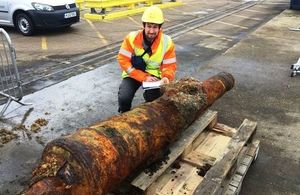Portsmouth dredge preparations unearth historic cannon
An iron cannon has been unearthed during work to prepare HMNB Portsmouth for the arrival of the Queen Elizabeth Class carriers.

Paolo Croce, Marine Archaeologist, Wessex Archaeology with the recovered cannon at North Quay, Portsmouth International Port. Photo: Gerrit Jan Van Den Bosch/Boskalis Westminster. All rights reserved.
The relic was recovered during a seabed clearance which is part of a £31 million programme to dredge Portsmouth Harbour to make it wide and deep enough for the 2 new carriers.
The cannon was found by Boskalis Westminster, which has been contracted by the Defence Infrastructure Organisation (DIO) to carry out the dredging programme.
The discovery was swiftly reported to the project’s archaeological advisors, Wessex Archaeology, which recorded the cannon. This will enable further research to be completed to determine how the cannon came to be in the harbour and how old it is. DIO Project Manager Paul Simmonds said:
The work underway at HMNB Portsmouth is vital in order to ensure the right infrastructure is in place ready for the arrival of the Queen Elizabeth Class Carriers. The artefacts being recovered as part of the dredging process offer a fascinating insight into the naval history of this significant sea port and I am delighted that they are being retained in the local area.
Speaking on behalf of Wessex Archaeology, Andrea Hamel, Senior Marine Archaeologist said:
We have already recovered a number of anchors, a quantity of modern glass and a range of ceramics during the dredging but cannons are particularly exciting finds because they could indicate the presence of a previously unrecorded shipwreck. However in this case, the cannon appears to be an isolated discovery. More investigation into the cannon will be needed to determine its significance, but hopefully ongoing research will provide a date-range for the cannon and possible provenance.
The cannon has now been transported to the Mary Rose Trust where it will be stored while decisions are made about its future conservation before travelling to its eventual home at Portsmouth Museum along with a range of the other artefacts found during the project.